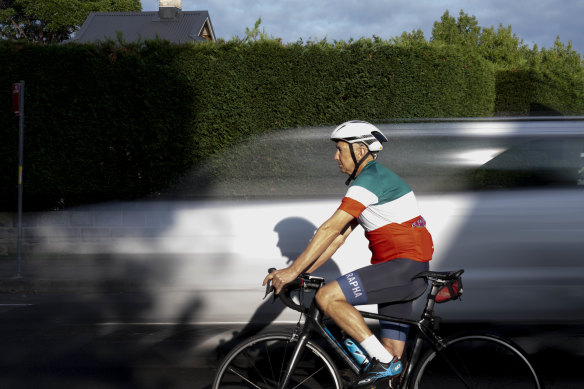By Nigel Gladstone and Julie Power
Cyclist David Page has been threatened by angry motorists a dozen times. They’ve hurled abuse, a full bottle of Coke, a lit firework and even a motorcycle helmet at him as they drove too close, violating a law requiring motorists to keep at least a metre away.
During one of these road rage episodes, a bystander called police alerting them to an “attempted murder” after they saw a motorist driving aggressively towards Page.

Cyclist David Page has experienced at least 12 serious incidents of dangerous driving and abuse from motorists while on the road in Sydney.Credit: Janie Barrett
“If you want to kill someone, do it with a car because you will always get off,” said Page, a doctor who lives near Turramurra.
A record number of NSW cyclists – 2330 – were taken to hospital in 2021, the most since complete hospital records began to be collected in 2005.
Bike riders now represent about one in four (23 per cent) road crash hospitalisations, and are the only road user group to report increasing injury numbers recently.
From 2005 to 2021, 173 bicyclists were killed and 29,464 were seriously injured on the state’s roads. However, many of these injuries were not reported to police and did not involve another vehicle, Transport for NSW said.
Bicycle NSW chairman of advocacy John Hawkins said, “Most cyclist complaints to NSW police about aggressive driving are not investigated.”
Page said he discovered that a report he made in January to Crime Stoppers about a motorist who threatened him on Bobbin Head Road in Turramurra – on a spot marked with a large bicycle sign – couldn’t be found when he followed up with the local police station.
In NSW, drivers must give bicycle riders at least one metre of space when passing them in areas where the speed limit is 60km/h or less, and at least 1.5 metres when the speed limit is more than 60km/h.
Hawkins, an accountant, understands how much work it is to prosecute this road rule and prove beyond a reasonable doubt that a driver violated the law.
So he “does the work” for NSW Police. He provides video evidence, a pre-written statement, and video screenshots marked to road landmarks and the distance of the motorist, aiming to meet the burden of proof for police to act.
He sends complaints by registered mail to the highest ranking officer in a station, which ensures it is logged in the system and then follows up by telephone.
NSW Police refused to answer questions about fines, requests to investigate dangerous driving or their enforcement activity.
A police spokesman said, “You must submit a GIPA [freedom of information] request for the information you are seeking.”
In the 12 months to the end of January 2023, 20 fines were issued to drivers in NSW for breaking the minimum passing distance rule, but none in the Christmas holiday period of December and January despite several statewide traffic blitzes.
Since the safe passing law was introduced in 2018, after a trial from 2016 showed it made cycling safer, police have issued 171 fines to motorists for driving too close to riders. Four of these can be credited to Hawkins.
Hawkins understands why police shy away from pinging drivers as there is “a high evidentiary burden” to meet for a violation that results in a $352 fine and two demerit points.
In contrast, he says cyclists draw disproportionate police enforcement.
“Cops like easy targets. And cyclists, who tend to be law-abiding, don’t run away. In comparison, policing the source of the greatest harm to riders – poor driving – often seems like too much work,” said Hawkins.
Since 2016, cyclists have received about 55,000 fines for a range of offences, mostly for not wearing a helmet or not having it correctly fastened (31,402 penalties), riding on the footpath (5645 fines), riding at night without a light (5678) and not having a working bell (2476). There have also been 207 fines for “not ride on far-left side of road” (sic).
To reduce cycling fatalities and injuries, Transport for NSW launched the Share the Road campaign last October to remind cyclists and motorists of their mutual responsibilities. The campaign will be screened again this month.
Since the safe distance rules were introduced, the public has become increasingly polarised, researchers and cyclists say.
A review of the law in Western Australia, for example, found the rules had made cycling safer, and drivers reported giving cyclists more space when overtaking, but there were unintended consequences.
“Drivers also self-reported more aggressive behaviour directed at cyclists, such as beeping horns or swearing,” the report by academics from the University of Western Australia said.
Hawkins said international cyclists visiting Australia often comment on how poorly motorists treat them in contrast to other countries.
Page said there was a bias against cyclists in society. Part of the problem was the lack of respect cyclists receive. But he says it is a two-way street: they have to treat motorists with respect, too.
An increasing number of cyclists are attaching high-definition cameras to their bikes to record these incidents. Page and Hawkins say this evidence is vital to the success of any complaint.
The Morning Edition newsletter is our guide to the day’s most important and interesting stories, analysis and insights. Sign up here.